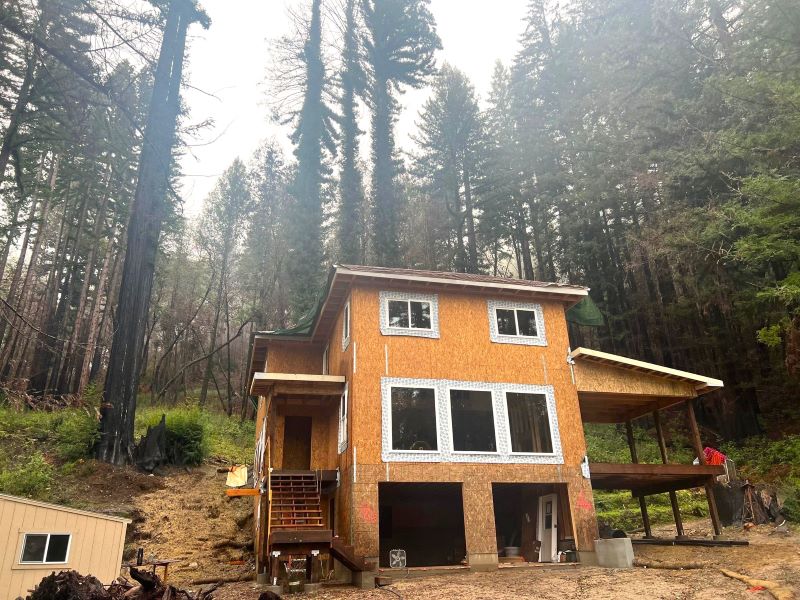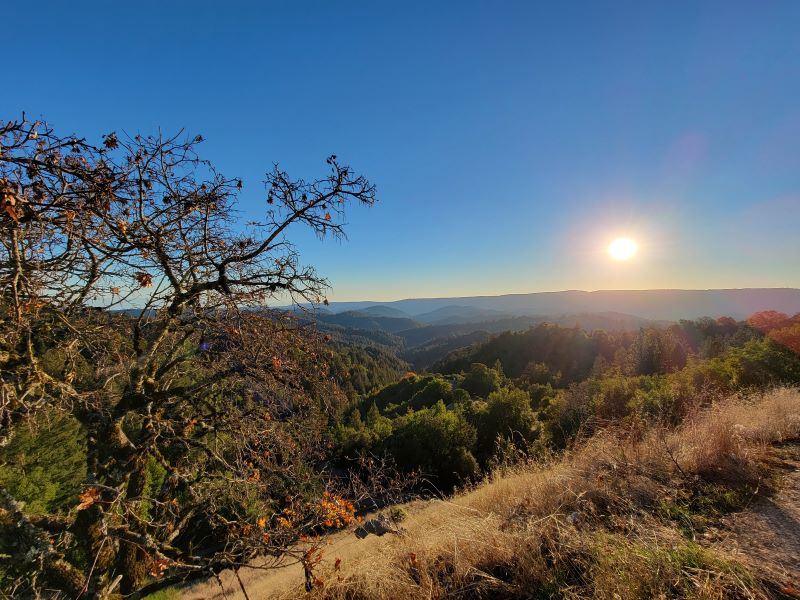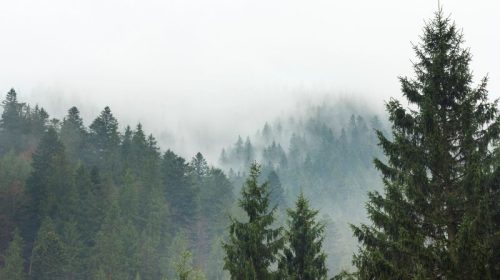Fire Recovery Challenges Ongoing
Rebuilding Efforts after the 2020 CZU Fires Hindered by Dysfunction
By Mary Andersen
Ringing in the New Year brings anticipation of new beginnings. Here’s hoping so; it’s been a rough couple of years. In March 2020, Covid upended our lives and changed the way we work, socialize, and debate. We’re still recovering. Politics — national and regional — have been volatile. And up here in the Santa Cruz Mountains, we’ve endured the tragedy of the August 2020 CZU Lightning Complex fires and the ongoing challenges of fire recovery, from which most say we’ve seen very little actual recovery.
In conversation with San Lorenzo Valley locals, we hear that the 2023 topic foremost in mind is fire recovery, and now storm recovery, followed by fire preparedness, business recovery, education recovery, infrastructure resilience and maintenance, access to social services, and solutions to the wide-ranging problems of homelessness and drug addiction. While we’ll look at all of these issues over the coming months, for this column we’ll focus on fire recovery and how authentic and engaged representation is key to getting the resources we need.
Fire Recovery
In a word: slow. As of this writing, of the 911 homes destroyed in the fire only 24 have been rebuilt. According to the County’s CZU Fire Recovery Permit Center Dashboard, only 186 properties have cleared the technical hurdles of fire access, environmental health-sewage disposal, and geologic hazard to be able to submit for a dwelling unit permit. However, those numbers are skewed given that the dashboard erroneously includes data for properties not impacted by the CZU fires. County staff when asked about the faulty data in August 2022, responded that they were aware of the anomalies and would investigate. Five months later, the dashboard has not been corrected.
Months after the fire, at the end of 2020, the Board of Supervisors authorized the creation of the Santa Cruz County Office of Response, Recovery & Resilience (OR3) modeled after Sonoma County’s Office of Recovery and Resiliency formed in response to the 2017 Sonoma Complex Fires; the Nuns, Tubbs, and Pocket Fires which burned 110,700 acres. The department’s goals are to act as the emergency management office for future weather disasters due to climate change, minimize impacts from future emergencies, and coordinate recovery efforts. It has struggled to be effective and its lead staff is unresponsive. The website doesn’t list a phone number and emails from fire families are typically ignored.
The OR3 project also includes the Long Term Recovery Group (LTRG) subcommittee formed with nonprofit, faith-based, and public agency organizations collaborating to provide resources to fire victims. Some of those organizations within the LTRG have been helpful with outreach and emergency funds. But for the most part, this organization suffers from communication challenges and lack of substantive member participation.
The County’s Board of Supervisors (BoS) also approved a “not-to-exceed” $6.2 million contract with 4Leaf, a project management firm with focus on construction management and disaster recovery. The Pleasanton-based company was tasked with managing the County’s Recovery Permit Center, which launched to great fanfare after the fire with promises of a more “streamlined” and responsive permitting system.
But, if you’ve paid attention to long-standing complaints about the County’s planning department, you know that obstruction to private residential building and apathy toward property owners has been the decades-long dominant culture. County staff confirms that this mindset is in place to this day along with the tepid, apologetic offering that they’re “trying to change the culture.”
In that light, story after story from fire victims confirms that the word “streamlined” has little to do with their rebuilding experience. Fire families are in agreement that staff at all of the above-mentioned agencies, along with supervisors’ offices, refuse to respond to queries, respond rudely or petulantly, or provide information that contradicts other departments thereby leading to dead-ends, delays, frustration, and great additional expense.
The County’s contract with 4Leaf dictated that 4Leaf would have its own experts and be allowed to act autonomously, but that has not turned out to be the case. According to numerous rebuilders, 4Leaf started out effectively, but after six months rotated out helpful workers and began realizing pressure from the County to overenforce on geology and septic issues. 4Leaf decision makers are located anywhere from Pleasanton to Newport Beach and suffer from the same malady as other agencies involved with recovery by being unresponsive or sending people on wild goose chases trying to locate a decision maker.
Steve Homan, a semi-retired consulting Registered Environmental Health Specialist, who has advised 40 CZU fire families on a pro bono basis said, “I tell all clients don’t build anything you didn’t already have beyond 500 feet more living space. No additional bedrooms or ADUs, no extra things that would trigger a new code clause.” Those who can afford it have no difficulty with a payment for a new package septic system at $65,000. For the underinsured who might not be wealthy, that’s not an option. The fewer opportunities for overenforcement, the better.
Additionally, County staff told the Post that, in order to juke their percentages, they don’t honor the number of 911 families who lost their homes. Rather, a spokesperson in May 2022 asserted that the county’s number is 640, saying “We’ve only ever heard from about 640 unique property owners. We’re coming up on two years, so if we’ve never heard even so much as an inquiry from a property, we doubt the owner is interested in rebuilding.” Let that sink in.
Those of us here who know so many families who lost their homes to the CZU fire know that some were forced to move – some temporarily, some permanently, sometimes out of state. Many are tight on funds. Some have sold or are selling their properties because dealing with the county is just not worth the anxiety and trauma. But universally the ones who have paused have done so because they’ve watched their neighbors endure a disorganized and unsympathetic process and they are not quite ready to jump into that mix. But, they’re still holding on to their options. To belittle fire victims by reducing their numbers is unconscionable. Yet here we are.
All along, the County has emitted press releases touting frameworks in place. Not so good news: real-life application is hindered by leadership challenges coupled with a focus on punitive obstacles and public relations over recovery. A former organizer of the LTRG referred to their fire recovery work as “a long journey and we’re just now building the airplane.” That’s not helpful to families who thought they’d be back home by summer 2021.
A County staffer told the Post that, immediately after the fire, planning leadership stated that they “didn’t want 20% of the 911 to rebuild.” They’ve surpassed their goal. What is the rationale for “not allowing” 20% to rebuild? Increased parklands, conserving SLV’s water resources for neighboring districts, spite? Whatever the rationale, it’s inhumane.

Additional Obstacles to Rebuilding
Many families continue to be stuck in the permit preclearance process, struggling to find resolutions to such issues as road repair and fire access, environmental health/sewage disposal, and geologic constraints. Geologic constraints remain an issue primarily for Boulder Creek rebuilders due to terrain. County legal counsel had been pushing hard on debris flow as an obstacle to building in part for liability reasons.
Insurance issues plague most fire victims. Construction costs have skyrocketed beyond what homeowners anticipated when securing their policies. Most are underinsured, lacking sufficient basic, extension, and code upgrade coverage. Some have run out of Additional Living Expense (ALE) insurance coverage and others will run out at the end of three years from the CZU Fire Disaster Declaration. Finally, many policies have been canceled leaving rebuilders in the lurch. Some are facing homelessness.
Additional problems plaguing fire victims who are trying to get their homes built and finaled:
– PG&E repair delays
– Big Basin Water infrastructure repair delays
– Conflicting solar permit requirements
– Fire victims intimidated into signing deeds against their properties
– Rebuilds continue to be treated as new builds
Immediate solutions? The agencies involved with Fire Recovery should shift their strategies to include competent leadership, responsiveness with accurate communications, and processes that actually support fire victims. After two and a half years, that promised roadmap to recovery and streamlined processes should have been developed and firmly in place by now.
Good News
There is good news. Many families in the midst of rebuilding say that 4Leaf, for all of its communications flaws and uneven decisions, operates better than the Planning Department. That 4Leaf’s intended separation from the County is a positive, for the most part offering paths to rebuilding. 4Leaf staff are capable of conceding overreach when presented with data, as opposed to the County’s culture of obstruction and interference.
A reshuffling of County planning divisions may bring positive changes in the new year. In February 2022, the BOS approved a plan to merge Public Works with the Planning Department, a year-long move that should eventually lead to streamlining. The newly blended entity — the Community Development and Infrastructure Department — finds former Public Works Director Matt Machado at the helm. Machado has already proven to be communicative and helpful, responding quickly when contacted.
Participating SLV members of the LTRG have been instrumental in providing community meetings, information workshops, and early on offered a sense of community through free meals and mental health resources. Most importantly, members of the mountain community — professionals in construction, real estate, insurance and legal services — have consistently provided the most accurate information and no-cost/low-cost advice in moving forward with rebuilding. Steve Homan has shown that when families partner with independent specialists, the County’s obstruction can be unraveled.
Representation
Representation matters because many of the obstacles detailed above could have been ameliorated if fire victims had a representative advocate.
Supervisors, as representatives of their districts, oversee the conduct and culture of county officers that, in our area, have been problematic for decades. They pull the levers of government that bring actionable resources to a community in distress. Then in the aftermath of disasters – like the CZU fires and recent storms – they focus their energies on actions that make our communities safer and more resilient. At minimum, they keep communication channels open and make sure they and their surrogates know the challenges of the district.
In the 5th District, the city of Scotts Valley has its own very active and advocacy-minded city council. The San Lorenzo Valley — almost three times the size of Scotts Valley in population and 15 times the actual land size — has been represented solely by supervisors who, in the last 20 years, have been residents of Scotts Valley and Pasatiempo. Currently neither Supervisor Bruce McPherson nor any of his staff resides in, or has strong connections to, the San Lorenzo Valley. According to McPherson, one of his aides lives in Sacramento – a real problem for constituent services. And overall, we’ve never had representation that reflects the diversity or needs of our region.
What’s the Solution?
In the short term until 2024, diverse groups have ramped up discussions on various forums where communication can flow more readily between constituents and electeds. One such example is the San Lorenzo Valley Community Forum, which received establishment pushback when first announced. These ideas don’t arise in a vacuum. For the most part, we like to be left to our own devices. However, when crises arise and a community sees weakness in the power structure, there can be a rush to fill the space with solutions that have our region’s interest at heart. One would think a connection to a broader swath of the community would be a good idea.
The 5th district is abundant with natural resources coveted by competing interests. We’ve recently endured boundary battles, water battles, and unexplainable loss of crucial funding. A positive outcome is that those very public battles have led to an upswing in folks interested in running for public office. The district now is a much different place than it was 20 years ago – and since then – with a very homogenous Board of Supervisors. It’s younger, more diverse, and recent and upcoming elections are just a start toward bringing a wider range of experiences to the table.
Conversations around the valley these past several years have been all about the deficiencies of storm recovery, fire recovery, pandemic recovery, and representation on multiple social services issues. The stories are heartbreaking. Stronger and more authentic leadership is in order. Electeds should understand the futility of positioning reputation management over actual solutions that restore and improve the lives of their constituents.
We’ll expand on these issues throughout the coming year, including tackling more on recovery and preparedness as well as residents’ concerns about business, education, infrastructure, social services, homelessness, and public safety.
Mary Andersen writes about politics and culture in Santa Cruz County. mary@slvpost.com
Featured photo: Santa Cruz Mountains with a vista over the San Lorenzo Valley (Photo by Julie Horner)
The San Lorenzo Valley Post is your essential guide to life in the Santa Cruz Mountains. We're dedicated to delivering the latest news, events, and stories that matter to our community. From local government to schools, from environmental issues to the arts, we're committed to providing comprehensive and unbiased coverage. We believe in the power of community journalism and strive to be a platform for diverse voices.





